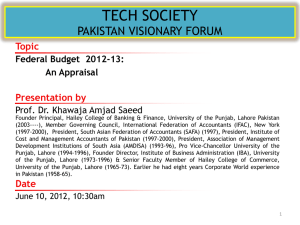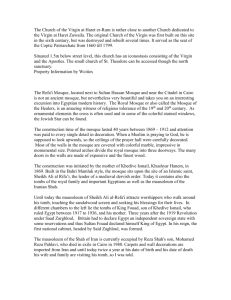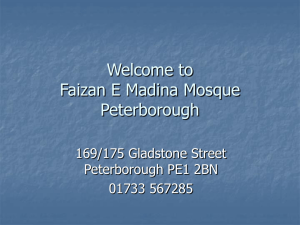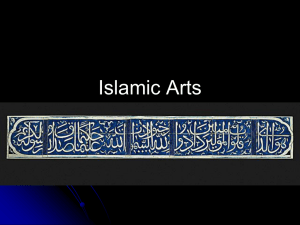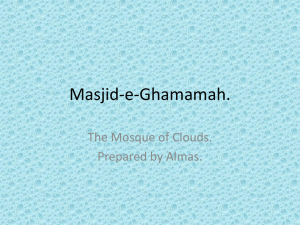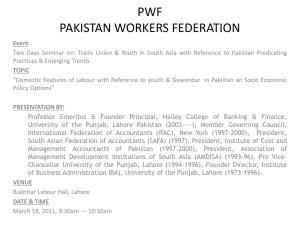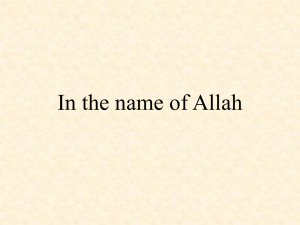ICT ppt.presentation
advertisement
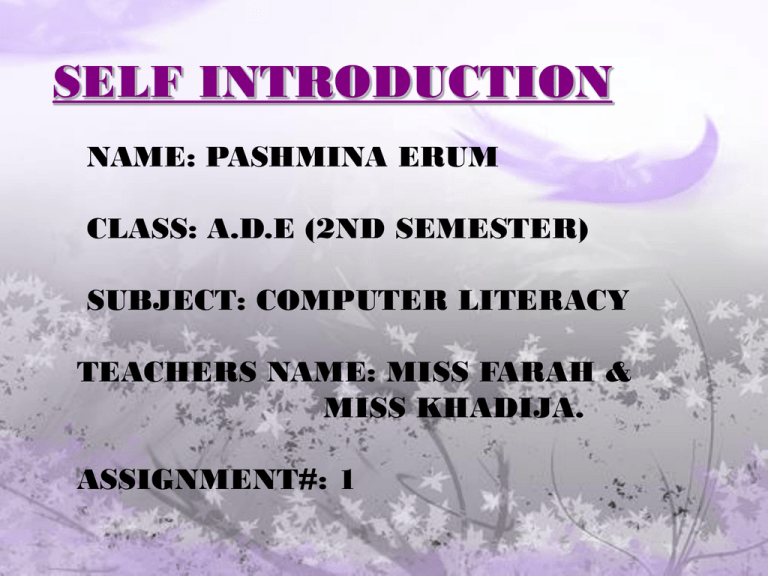
SELF INTRODUCTION NAME: PASHMINA ERUM CLASS: A.D.E (2ND SEMESTER) SUBJECT: COMPUTER LITERACY TEACHERS NAME: MISS FARAH & MISS KHADIJA. ASSIGNMENT#: 1 TOMB OF QUIAD-E-AZAM • Mohammed Ali Jinnah died on December 25,1948. • Mazar-e-Quaid is the tomb of the founder of Pakistan, Muhammad Ali Jinnah. • It is an iconic symbol of Karachi throughout the world. • The Mazar-e-Quaid has been officially recognized as the National Mausoleum of the country. • The mausoleum is made of white Marble with curved Moorish arches and copper grills rest on an elevated 54 meters square platform. TOMB OF ALLAMA IQBAL • Iqbal died on April 21, 1938 in Lahore at the age of 60. • The Tomb of Allam Muhammad Iqbal is a simple but impressive structure located in Lahore, Pakistan in the Hazuri Bagh lawn between the Badshahi Mosque and the Lahore Fort where both the grand structures (the Mosque and the Fort) face each other. • The architecture reflects a combination of Afghan and Moorish styles and is entirely constructed of red sandstone. • The tombstone was a gift from the people of Afghanistan. TOMB OF SHAH ABDUL LATIF • Bhit Shah is famous for the tomb of Shah Abdul Latif Bhitai (1689–1752) who is considered by far the greatest poet of Sindhi language. • The shrine is situated on a ‘Bhit’ (mound) and hence the name of the place Bhit Shah, the Mound of the King. • The tomb was raised by the first of the Kalhoras and subsequently beautified by the Talpur Mirs. • The tomb and an adjacent mosque are famous for the tile and mirror work done on them. TOMB OF DATA GANJ BAKSH • He was born in 400 A.H. in Ghazni, Afghanistan to a Syed family and died at the age of 65 in 465 A.H., in Lahore. • Data Darbar (or Durbar), located in the city of Lahore, Pakistanis one of the oldest Muslim shrines in the subcontinent. • It houses the remains of a Sufi saint, Abul Hassan Ali Hajvery (more commonly known as Daata Ganj Baksh. • The shrine is located near the Bhaati Gate into Lahore's Walled City. • It was originally built by the Ghaznavi king Sultan Zakiruddin Ibrahim in the late eleventh century, and has been expanded several times. PESHAWAR GATE • The Khyber gate PESHAWAR (Urdu: ( )درۂ خیبرaltitude: 1,070 m or 3,510 ft) is a mountain pass that links Pakistan and Afghanistan. • Throughout history it has been an important trade route between Central Asia and South Asia and a strategic military location. • The summit of the Khyber Pass is 5 kilometres (3.1 mi) inside Pakistan at Landi Kotal and it cuts through the northeastern part of the Safed Koh mountains which themselves are a far southeastern extension of the Hindu Kush range. • In some versions of the Aryan migration theory, the Indo-Aryans migrated to India via the Khyber Pass. SHALIMAR GARDEN • Shalimar Garden Lahore built in 16th Century by Shahjehan the greatest patron of Architecture. It was used as the Royal pleasure Garden by the Moghuls during 16th to 19th century. • In 1818 It saw its worst days when it was destroyed by the Sikh ruler Ranjit sing and was used as stable. • During English times (18421947) It regained its value as the Garden and was open to Public. • After English the Garden was restored by the Pakistan Government and it in use today as popular hang out site. MAKLI GRAVEYARD • An eternal abode to hundreds of thousands who died over the ages, Makli graveyard is the ancient one and the largest necropolis in the world. • Situated at Makli Hills, next to once the cradle of civilization, the Thatta city, some 98 kilometers east of Karachi, the graveyard spreads on over 10 square kilometers. • Here in eternal sleep lie kings, queens, scholars, philosophers and soldiers of a by-gone era - an era renowned for its culture and learning. • This graveyard also reveals the history and craftsmanship of Sammas, Arghuns and Tarkhans and Mughals dynasties, spanning over four centuries. • Makli graveyard is also believed to be the burial place of thousands of Sufi saints. LAHORE FORT • Lahore Fort is located at an eminence in the northwest corner of the Walled City. • The citadel is spread over approximately 50 acres and is trapezoidal in form. • Built, damaged, demolished, rebuilt and restored several times before being given its current form by Emperor Akbar in 1566 (when he made Lahore his capital), the Lahore Fort is the star attraction of the Old City. • The present fort, in brick and solid masonry, was built during Akbar's reign between 1556 and 1605. • It is the only monument in Pakistan which represents a complete history of Mughal architecture. BADSHAHI MASJID • Badshahi mosque is one of the few significant architectural monuments built during Emperor Aurangzeb's long rule from 1658 to 1707. • It is presently the fifth largest mosque in the world and was indisputably the largest mosque in the world from 1673 to 1986 when the Faisal Mosque was constructed in Islamabad. • The construction of the mosque took about two years, from May 1671 to April 1673. • The mosque was built opposite the Lahore Fort, illustrating its stature in the Mughal Empire. • Recently a small museum has also been added to the mosque complex, which contains relics of Muhammad, his cousin, and his daughter, Hazrat Fatima Zahra. KING FAISAL MOSQUE • The Faisal Mosque is the largest mosque in Pakistan and is located in the national capital city of Islamabad. • The mosque is situated at the end of Shaharah-e-Islamabad, against the backdrop of the picturesque Margalla Hills. • The mosque is dedicated to the memory of the late King Faisal of Saudi Arabia who graciously defrayed the cost of the project as a gift to the people of Pakistan. • The Faisal Mosque is the work of famous Turkish architect, Vedat Dalokay who won the Aga Khan Architectural Award with this project. REFERENCES • • • • • • • • • • • • http://www.aulia-e-hind.com http://www.baharemadinah.com http://en.wikipedia.org http://epeshawar.memebot.com/khyber_gate.html http://www.travel-culture.com http://www.app.com.pk http://www.ualberta.ca/~rnoor/lahore_fort.html http://www.lonelyplanet.com http://www.sacred-destinations.com http://www.orientalarchitecture.com http://en.wikipedia.org/wiki/Faisal_Mosque http://archnet.org The End

